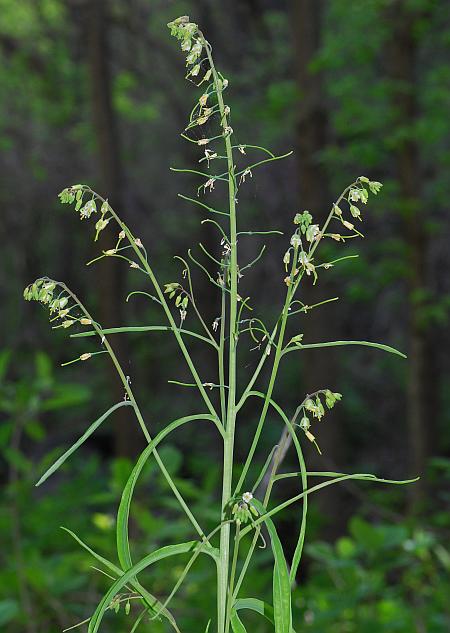Boechera laevigata (Muhl. ex Willd.) Al-Shehbaz
Smooth Rock Cress

Native
CC = 6
CW = 5
MOC = 57
© SRTurner
Boechera laevigata (Muhl. ex Willd.) Al-ShehbazSmooth Rock Cress | |
 |
Native CC = 6 CW = 5 MOC = 57 |
© SRTurner |
|
Family - Brassicaceae Habit - Biennial forb with taproot. Stems - Erect, to 1 m, pale green, glabrous, glaucous, branching or simple.
Leaves - Alternate, simple. Basal leaves often withered by flowering time, 3-11 cm long, obovate to narrowly oblanceolate in outline, toothed or entire, short petiolate, sometimes pubescent. Stem leaves mostly spreading, sometimes overlapping, 3-15 cm long, narrowly lanceolate to linear in outline, sessile, clasping the stem, acute, entire or toothed, glabrous, glaucous, usually with pointed basal auricles, these completely surrounding the stem on larger leaves.
Inflorescence - Terminal and axillary racemes, elongating in fruit. Pedicels glabrous, to 5 mm in flower, elongating in fruit to 2 cm, erect to spreading.
Flowers - Sepals 4, 2.5-4.0 mm long, oblong-elliptic, light green, slightly cupped, erect, glabrous. Petals 4, 3-5 mm long, white, glabrous, tapering to the base, blunt to truncate or wavy at the apex, slightly exceeding or equaling the sepals. Stamens 6, 4 alike and 2 slightly smaller. Filaments to 5 mm long, white, glabrous, erect. Anthers yellow, 1.2 mm long. Ovary cylindric, green, glabrous, 3.4 mm long, 0.5 mm in diameter, 2-valved. Style very short, 0.1-0.2 mm long. Stigma capitate.
Fruits - Siliques 5-10 cm long, 1.0-2.0 mm wide, widely ascending to spreading horizontally along the lower half, arched downward toward maturity, somewhat flattened. Seeds in 1 row in each locule, 1.3-1.8 mm long, oblong in outline, flattened, winged, the surface with a netlike or honeycomb-like pattern of ridges and pits, orange.
Flowering - April - June. Habitat - Forests, streambanks, bluffs, ledges, often on calcaerous substrate. Lookalikes - Boechera missouriensis. Origin - Native to the U.S. Other info. - This inconspicuous but readily recognizable species is found mainly in the southern half of the state. It is also common throughout most of the eastern half of the U.S., and ranges into Canada as well. The flowers are typical for a mustard, with this particular species being distinguished by its long, narrow, clasping leaves and overall smoothness. Most parts of the plant are distinctly glaucous, with a waxy coating which can easily be rubbed off. A similar species is B. missouriensis, but that is a leafier plant which has pinnately lobed basal leaves, and is also not glaucous. These plants tend to prefer rocky areas and are colloquially known as "rock cresses" for that reason. Photographs taken at Eagle Bluffs Conservation Area, Boone County, MO., 4-11-04 (DETenaglia); and also in Weldon Spring Conservation Area, 4-17-2014, Salt Lick Point, Monroe County, IL, 4-30-2018, Amidon Conservation Area, Madison County, MO, 3-26-2020, and Meramec Conservation Area, Franklin County, MO, 4-21-2020 (SRTurner). |